Impact of Diagenesis on the Low Permeability Sandstone Reservoir: Case Study of the Lower Jurassic Reservoir in the Niudong Area, Northern Margin of Qaidam Basin
Abstract
:1. Introduction
2. Geological Setting
3. Samples and Methods
3.1. Casting Section
3.2. Granularity Analysis
3.3. Scanning Electron Microscope
3.4. X-ray Diffraction Analysis
3.5. Helium Porosity
3.6. Maturity of Organic Matter
3.7. Carbon and Oxygen Stable Isotope Analysis
4. Results
4.1. Reservoir Petrological Characteristics
4.2. Pore Types and Pore Throat Characteristics
4.3. Porosity and Permeability
4.4. Diagenesis
4.4.1. Compaction
4.4.2. Cement
Carbonate Cement
Quartz Overgrowth
Authigenic Clay Minerals
- Kaolinite
- Illite
- Illite/Smectite Mixed Layer
- Chlorite
4.4.3. Dissolution
4.5. Maturity of Organic Matter
4.6. Carbon and Oxygen Stable Isotope
5. Discussion
5.1. The Evolution of Reservoir Porosity
5.1.1. Initial Porosity of Unconsolidated Sandstone
5.1.2. Porosity of Compacted Sandstone
5.1.3. Porosity of Sandstone after Cementation
5.1.4. Secondary Porosity
5.1.5. Fractures
5.1.6. Pore Evolution Analysis
5.2. Diagenetic Stages and Paragenetic Sequence
5.3. Controlling Factors of Reservoir Quality
5.3.1. Control of Sedimentation
5.3.2. Control of Diagenesis
Compaction
Calcite Cement
Clay Minerals
Dissolution
5.3.3. Fracture
6. Conclusions
Author Contributions
Funding
Data Availability Statement
Acknowledgments
Conflicts of Interest
References
- Adibhatla, B.; Mohanty, K.K. Parametric analysis of surfactant-aided imbibition in fractured carbonates. J. Colloid Interface Sci. 2008, 317, 513–522. [Google Scholar] [CrossRef]
- Li, S.; Zhang, K.; Jia, N.; Liu, L. Evaluation of four CO2 injection schemes for unlocking oils from low-permeability formations under immiscible conditions. Fuel 2018, 234, 814–823. [Google Scholar] [CrossRef]
- Wang, L.; Tian, Y.; Yu, X.; Wang, C.; Yao, B.; Wang, S.; Winterfeld, P.H.; Wang, X.; Yang, Z.; Wang, Y.; et al. Advances in improved/enhanced oil recovery technologies for tight and shale reservoirs. Fuel 2017, 210, 425–445. [Google Scholar] [CrossRef]
- Shanley, K.W.; Cluff, R.M.; Robinson, J.W. Factors controlling prolific gas production from low-permeability sandstone reservoirs: Implications for resource assessment, prospect development, and risk analysis. AAPG Bull. 2004, 88, 1083–1121. [Google Scholar] [CrossRef] [Green Version]
- Zhiqiang, Z.; Junwei, Z. Advances in exploration and exploitation technologies of low-permeability oil and gas. Adv. Earth Sci. 2009, 24, 854–864. [Google Scholar]
- Hu, W.; Wei, Y.; Bao, J. Development of the theory and technology for low permeability reservoirs in China. Pet. Explor. Dev. 2018, 45, 685–697. [Google Scholar] [CrossRef]
- Li, Q.; Zhang, L.; Husein, M. Production performance by polymer conformance control in ultra-low permeability heterogeneous sandstone reservoirs produced under their natural energy. J. Pet. Sci. Eng. 2020, 193, 107348. [Google Scholar] [CrossRef]
- Li, P. Microscopic Pore Structure Characterization and Production Characteristic Analysis of Low-Permeability Sandstone Reservoir: A Case Study and Chang. 4+5 and Chang. 6 Reservoir of T Area in Jiyuan Oilfield; Northwest University: Xi’an, China, 2019. [Google Scholar]
- Xinzhi, Z. Characteristics and Grading Evaluation of Low Permeability Reservoir in the Longdong Region, Ordos Basin; China University of Geoscience: Wuhan, China, 2012. [Google Scholar]
- Hu, W. The present and future of low permeability oil and gas in China. Eng. Sci. 2009, 11, 29–37. [Google Scholar]
- Zou, C.; Zhu, R.K.; Wu, S.T.; Yang, Z.; Tao, S.Z.; Yuan, X.; Hou, L.; Yang, H.; Xu, C.; Li, D.; et al. Types, characteristics, genesis and prospects of conventional and unconventional hydrocarbon accumulations: Taking tight oil and tight gas in China as an instance. Acta Pet. Sin. 2012, 33, 173–187. [Google Scholar]
- Zou, C.; Yang, Z.; Zhang, G.; Hou, H.; Zhu, R.K.; Tao, S.Z.; Yuan, X.J.; Dong, D.Z.; Wang, Y.M.; Guo, Q.L.; et al. Conventional and unconventional petroleum “orderly accumulation”: Concept and practical significance. Pet. Explor. Dev. 2014, 41, 14–30. [Google Scholar] [CrossRef]
- Zhao, J.Z.; Wu, S.B.; Wu, F.L. The classification and evaluation criterion of low permeability reservoir: An example from Ordos Basin. Lithol. Reserv. 2007, 3, 28–31. [Google Scholar]
- Li, D. The Development of Low-Permeability Sandstone Oilfields; Petroleum Industry Press: Beijing, China, 1997; p. 354. (In Chinese) [Google Scholar]
- Jiang, L.Z.; Gu, J.Y.; Guo, B. Characteristics and mechanism of low permeability clastic reservoir in Chinese Petroliferous Basin. Acta Sedimentol. Sin. 2004, 22, 13–18. [Google Scholar]
- Wang, G.; Chang, X.; Yin, W.; Li, Y.; Song, T. Impact of diagenesis on reservoir quality and heterogeneity of the Upper Triassic Chang 8 tight oil sandstones in the Zhenjing area, Ordos Basin, China. Mar. Pet. Geol. 2017, 83, 84–96. [Google Scholar] [CrossRef]
- Katz, B.; Lin, F. Lacustrine basin unconventional resource plays: Key differences. Mar. Pet. Geol. 2014, 56, 255–265. [Google Scholar] [CrossRef]
- Taylor, T.R. Sandstone diagenesis and reservoir quality prediction: Models, myths, and reality. Am. Assoc. Pet. Geol. Bull. 2010, 94, 1093–1132. [Google Scholar] [CrossRef]
- Hu, Z.W.; Huang, S.J.; Li, X.N.; Qi, S.C.; Lang, X.G. Influence of pore-throat sizes on reservoir quality of low-permeability sandstone of Chang 2 oil-bearing bed from the Jiyuan, Ordos Basin. Xinjiang Geol. 2012, 30, 438–441. [Google Scholar]
- Zeng, D.Q.; Li, S.Z. Types and characteristics of low permeability sandstone reservoirs in China. Acta Pet. Sin. 1994, 1, 38–46. [Google Scholar]
- Spencer, C.W. Review of characteristics of low-permeability gas-reservoirs in western united states. Am. Assoc. Pet. Geol. Bull. 1989, 73, 613–629. [Google Scholar]
- Zhou, Y.; Ji, Y.; Xu, L.; Che, S.; Niu, X.; Wan, L.; Zhou, Y.; Li, Z.; You, Y. Controls on reservoir heterogeneity of tight sand oil reservoirs in Upper Triassic Yanchang Formation in Longdong Area, southwest Ordos Basin, China: Implications for reservoir quality prediction and oil accumulation. Mar. Pet. Geol. 2016, 78, 110–135. [Google Scholar] [CrossRef]
- Lai, J.; Wang, G.; Ran, Y.; Zhou, Z.; Cui, Y. Impact of diagenesis on the reservoir quality of tight oil sandstones: The case of Upper Triassic Yanchang Formation Chang 7 oil layers in Ordos Basin, China. J. Pet. Sci. Eng. 2016, 145, 54–65. [Google Scholar] [CrossRef]
- Bjorlykke, K. Relationships between depositional environments, burial history and rock properties. Some principal aspects of diagenetic process in sedimentary basins. Sediment. Geol. 2014, 301, 1–14. [Google Scholar] [CrossRef]
- Beard, D.C.; Weyl, P.K. Influence of texture on porosity and permeability of unconsolidated sand. Am. Assoc. Pet. Geol. Bull. 1973, 57, 349–369. [Google Scholar]
- Ajdukiewicz, J.M.; Lander, R.H. Sandstone reservoir quality prediction: The state of the art. Am. Assoc. Pet. Geol. Bull. 2010, 94, 1083–1091. [Google Scholar] [CrossRef]
- Ma, Y.; Li, W.; Ouyang, Z.; Zhang, D.; Meng, H. Reservoir characteristics and main control factors of Chang 6 oil-bearing formation in Western Nanliang Area of Ordos Basin. Geol. Bull. China 2013, 32, 1471–1476. [Google Scholar]
- Lai, J.; Wang, G.W.; Xin, Y.; Zhou, L.; Xiao, C.; Han, C.; Zheng, X.; Wu, Q. Diagenetic facies analysis of tight sandstone gas reservoir of Bashijiqike Formation in Kuqa Depression. Nat. Gas. Geosci. 2014, 25, 1019–1032. [Google Scholar]
- Shi, Y.J.; Xiao, L.; Mao, Z.Q.; Guo, H.P. An identification method for diagenetic facies with well logs and its geological significance in low-permeability sandstones: A case study on Chang 8 reservoirs in the Jiyuan region, Ordos Basin. Acta Pet. Sin. 2011, 32, 820–828. [Google Scholar]
- Dos Anjos, S.M.C.; de Ros, L.F.; de Souza, R.S.; de Assis, S.C.M.; Sombra, C.L. Depositional and diagenetic controls on the reservoir quality of Lower Cretaceous Pendencia sandstones, Potiguar rift basin, Brazil. Am. Assoc. Pet. Geol. Bull. 2000, 84, 1719–1742. [Google Scholar]
- Gier, S.; Worden, R.H.; Johns, W.D.; Kurzweil, H. Diagenesis and reservoir quality of Miocene sandstones in the Vienna Basin, Austria. Mar. Petr. Geol. 2008, 25, 681–695. [Google Scholar] [CrossRef]
- Bjorlykke, K.; Ramm, M.; Saigal, G.C. Sandstone diagenesis and porosity modification during basin evolution. Geol. Rundsch. 1989, 78, 243–268. [Google Scholar] [CrossRef]
- Schmidt, V.; McDonald, D.A. The role of secondary porosity in the course of sandstone diagenesis. Am. Assoc. Pet. Geol. Bull. 1979, 26, 8. [Google Scholar]
- Fu, J.H.; Wei, X.S.; Nan, J.X.; Shi, X.H. Characteristics and origin of reservoirs of gas fields in the Upper Paleozoic tight sandstone, Ordos Basin. J. Palaeogeogr. 2013, 15, 529–538. [Google Scholar]
- Shou, J.F.; Zhang, H.L.; Yang, S.; Wang, X.; Zhu, G.H.; Si, C.S. Diagenetic mechanisms of sandstone reservoirs in China and gas-bearing basins. Acta Pet. Sin. 2006, 22, 2165–2170. [Google Scholar]
- Ren, C.; Gao, X.; Zhang, Y.; Wang, B.; Hou, Z.; He, F.; Zhang, T. Structural characteristics and hydrocarbon control action of Paleogene/Jurassic unconformity in Niudong area, North Margin of Qaidam Basin. Acta Geosci. Sin. 2019, 40, 795–804. [Google Scholar]
- Xu, Z.; Tian, J.X.; Yang, G.R.; Bo, W.; Guo, Z.Q.; Wang, W.; Zhang, H.L. Structure characteristics and petroleum geological significance of Jurassic sags at the northern margin of Qaidam Basin. China Pet. Explor. 2017, 22, 54–63. [Google Scholar]
- Wu, Y.Y.; Song, Y.; Jia, C. Sedimentary features in a sequence stratigraphic framework in the north area of Qaidam Basin. Earth Sci. Front. 2005, 12, 195–203. [Google Scholar]
- Wu, Z.; Wang, B.; Zhao, J.; Zou, K.; Zhou, F.; Xiong, K. Diagenesis of Jurassic and its influence on reservoir properties in Niudong area, Eastern Altun Foreland. Lithol. Reserv. 2016, 28, 58–64. [Google Scholar]
- Zhang, W.; Jian, X.; Fu, L.; Feng, F.; Guan, P. Reservoir characterization and hydrocarbon accumulation in late Cenozoic lacustrine mixed carbonate-siliciclastic fine-grained deposits of the northwestern Qaidam basin, NW China. Mar. Pet. Geol. 2018, 98, 675–686. [Google Scholar] [CrossRef]
- Lv, B.; Zhang, Y.; Yang, S. Characteristics of structural system and its implication for formation dynamics in Qaidam Basin. Geol. Rev. 2011, 57, 167–174. [Google Scholar]
- Zhu, L.; Wang, C.; Zheng, H.; Xiang, F.; Yi, H.; Liu, D. Tectonic and sedimentary evolution of basins in the northeast of Qinghai-Tibet Plateau and their implication for the northward growth of the plateau. Palaeogeogr. Palaeoclim. Palaeoecol. 2006, 241, 49–60. [Google Scholar] [CrossRef]
- Wang, J.; Zhang, D.; Yang, S.; Li, X.; Shi, Y.; Cui, J.; Zhang, P.; Wang, Y.; Yi, D.; Chang, H. Sedimentary characteristics and genesis of the salt lake with the upper member of the Lower Ganchaigou Formation from Yingxi sag, Qaidam Basin. Mar. Pet. Geol. 2020, 111, 135–155. [Google Scholar] [CrossRef]
- Song, J.; Liao, J. Structure characteristics and petroliferous regions in the Chaidamu (Tsdam) Basin. Acta Pet. Sin. 1982, 8, 14–23. [Google Scholar]
- Hu, S.-Q.; Cao, Y.-J.; Huang, J.-X. Discussion on formation and evolution of Jurassic basin prototype of Qaidam basin. Pet. Geol. Exp. 1999, 21, 189–195. [Google Scholar]
- Tian, J.; Li, J.; Pan, C.; Tan, Z.; Zeng, X.; Guo, Z.; Wang, B.; Zhou, F. Geochemical characteristics and factors controlling natural gas accumulation in the northern margin of the Qaidam Basin. J. Pet. Sci. Eng. 2018, 160, 219–228. [Google Scholar] [CrossRef]
- Guo, Z.; Sun, P.; Li, J.; Zhang, L.; Liu, W.; Tian, J.; Zhang, S.; Zeng, S. Natural gas types, distribution controlling factors, and future exploration in the Western Qaidam Basin. Acta Geol. Sin. 2014, 88, 1214–1226. [Google Scholar] [CrossRef]
- Dickson, J.A.D. Carbonate identification and genesis as revealed by staining. J. Sediment. Pet. 1966, 36, 491–505. [Google Scholar]
- Hu, T.; Pang, X.; Yu, S.; Wang, X.; Pang, H.; Guo, J.; Jiang, F.; Shen, W.; Wang, Q.; Xu, J. Hydrocarbon generation and expulsion characteristics of Lower Permian P(1)f source rocks in the Fengcheng area, northwest margin, Junggar Basin, NW China: Implications for tight oil accumulation potential assessment. Geol. J. 2016, 51, 880–900. [Google Scholar] [CrossRef]
- Folk, R.L. Petrology of Sedimentary Rocks; Hemphill Publishing Company: Austin, TX, USA, 1980; p. 182. [Google Scholar]
- Yu, X. Reservoir Sedimentology of Clastic Rocks; Petroleum Industry Press: Beijing, China, 2000; p. 352. [Google Scholar]
- Zhou, Y. Research on diagenesis in Chang 8 Reservoir of Zhiluo Oilfield in Ordos Basin. Ground Water 2013, 35, 208–211. [Google Scholar]
- Fu, W. Influence of clay minerals on sandstone reservoir properties. J. Palaeogeogr. 2000, 2, 59–68. [Google Scholar]
- Wang, X.Z.; Zhang, L.X.; Yu, B.; Zhou, L.D.; Yin, J.T. Diagenesis of Shan-2 Member of Shanxi Formation in Yanchang Oil-Gas Field in Ordos Basin. Geol. Sci. Technol. Inf. 2013, 32, 114–118. [Google Scholar]
- Zhao, X. Analysis of Clay Minerals Content and Clay Minerals; China Ocean Press: Beijing, China, 1990; p. 341. [Google Scholar]
- Li, Y. Tight Sandstone Reservoir Microscopic Pore Throat Structure Fine characterization: With G3 and G4 of Gaotaizi Oil Layer in Qijia Area as an Example; Northeast Petroleum University: Daqing, China, 2017. [Google Scholar]
- Su, N. Research on the Characteristics and Genesis of Ultra-low Permeability Sandstone Reservoir of Chang. 8 in Heshui Area of Ordos Basin; Northwestern University: Xi’an, China, 2007. [Google Scholar]
- Ying, F. The Division of Diagenetic Stages in Clastic Rocks; Petroleum Industry Press: Beijing, China, 2003; p. 15. [Google Scholar]
- Chen, J.; Yao, J.; Mao, Z.; Li, Q.; Luo, A.; Deng, X.; Shao, X. Sedimentary and diagenetic controls on reservoir quality of low-porosity and low-permeability sandstone reservoirs in Chang10(1), Upper Triassic Yanchang Formation in the Shanbei area, Ordos Basin, China. Mar. Pet. Geol. 2019, 105, 204–221. [Google Scholar] [CrossRef]
- Rossi, C.; Kälin, O.; Arribas, J.; Tortosa, A. Diagenesis, provenance and reservoir quality of Triassic TAGI sandstones from Ourhoud field, Berkine (Ghadames) Basin, Algeria. Mar. Pet. Geol. 2002, 19, 117–142. [Google Scholar] [CrossRef] [Green Version]
- Morad, S.; Al-Ramadan, K.; Ketzer, J.M.; de Ros, L.F. The impact of diagenesis on the heterogeneity of sandstone reservoirs: A review of the role of depositional facies and sequence stratigraphy. Am. Assoc. Pet. Geol. Bull. 2010, 94, 1267–1309. [Google Scholar] [CrossRef]
- Morad, S. Carbonate Cementation in Sandstones: Distribution Patterns and Geochemical Evolution; Blackwell Publishing Ltd.: Hoboken, NH, USA, 2009. [Google Scholar]
- Irwin, H.; Curtis, C.; Coleman, M. Isotopic evidence for source of diagenetic carbonates formed during burial of organic-rich sediments. Nature 1977, 269, 209–213. [Google Scholar] [CrossRef]
- Siegel, D.I.; Lesniak, K.A.; Stute, M.; Frape, S. Isotopic geochemistry of the Saratoga springs: Implications for the origin of solutes and source of carbon dioxide. Geology 2004, 32, 257–260. [Google Scholar] [CrossRef]
- Sun, G.Q.; Wang, H.F.; Zou, K.Z.; Wang, W.Z. Characteristics and significance of carbon and oxygen isotopic compositions of carbonate cements in Jiulongshan region, North Edge of Qaidam Basin. Nat. Gas. Geosci. 2014, 25, 1358–1365. [Google Scholar]
- Fu, S.; Wang, Z.; Zhang, Y.; Wang, A.; Kong, H.; Fang, C. Origin of carbonate cements in reservoir rocks and its petroleum geologic significance: Eboliang structure belt, northern margin of Qaidam Basin. Acta Sedimentol. Sin. 2015, 33, 991–999. [Google Scholar]
- Li, Q.; Jiang, Z.; Liu, K.; Zhang, C.; You, X. Factors controlling reservoir properties and hydrocarbon accumulation of lacustrine deep-water turbidites in the Huimin Depression, Bohai Bay Basin, East China. Mar. Pet. Geol. 2014, 57, 327–344. [Google Scholar] [CrossRef]
- Zhong, D.K.; Zhu, X.M. Characteristics and genetic mechanism of deep-buried clastic eureservoir in China. Sci. China Ser. D 2008, 51, 11–19. [Google Scholar] [CrossRef]
- Surdam, R.C.; Crossey, L.J.; Hagen, E.S.; Heasler, H.P. Organic-inorganic interactions and sandstone diagenesis. Am. Assoc. Pet. Geol. Bull. 1989, 73, 1–23. [Google Scholar]
- Zhao, X. Clay Mineral and Application in Oil and Gas Exploration and Development; China Ocean Press: Beijing, China, 2012; p. 424. [Google Scholar]
- Mansurbeg, H.; Morad, S.; Salem, A.; Marfil, R.; El-Ghali, M.A.K.; Nystuen, J.P.; Caja, M.A.; Amorosi, A.; Garcia, D.; La Iglesia, A. Diagenesis and reservoir quality evolution of palaeocene deep-water, marine sandstones, the Shetland-Faroes Basin, British continental shelf. Mar. Pet. Geol. 2008, 25, 514–543. [Google Scholar] [CrossRef]
- Surdam, R.C.; Boese, S.W.; Crossey, L.J. The Chemistry of Secondary Porosity. Am. Assoc. Pet. Geol. Bull. Mem 1984, 37. [Google Scholar] [CrossRef]
- Yuan, G.; Gluyas, J.; Cao, Y.; Oxtoby, N.H.; Jia, Z.; Wang, Y.; Xi, K.; Li, X. Diagenesis and reservoir quality evolution of the Eocene sandstones in the northern Dongying Sag, Bohai Bay Basin, East China. Mar. Petr. Geol. 2015, 62, 77–89. [Google Scholar] [CrossRef]
- Zhou, G.; Chen, Q.; Cui, G.; Wang, G.; Wang, Y. Geological characteristics and main controlling factors of Paleogene-Neogene gas reservoir in the east of the Altun Mountains in the Qaidam Basin. J. Northwest Univ. 2018, 48, 115–122. [Google Scholar]
- Worden, R.H.; Burley, S.D. Sandstone Diagenesis: The Evolution of Sand to Stone; Blackwell Publishing Ltd.: Hoboken, NH, USA, 2009. [Google Scholar]
- Zheng, J.; Ying, F. Reservoir characteristics and diagenetic model of sandstone intercalated in coal-bearing strata (acid water medium). Acta Patrolei. Sin. 1997, 18, 19–24. [Google Scholar]
- Hower, J.; Eslinger, E.V.; Hower, M.E.; Perry, E.A. Mechanism of burial metamorphism of argillaceous sediment: 1. Mineralogical and chemical evidence. Geol. Soc. Am. Bull. 1976, 87, 725–737. [Google Scholar] [CrossRef]
- Zhu, H.H.; Zhong, D.K.; Yao, J.L.; Sun, H.T.; Niu, X.B.; Liang, X.W.; You, Y.; Li, X. Alkaline diagenesis and its effects on reservoir porosity: A case study of Upper Triassic Chang 7 Member tight sandstone in Ordos Basin, NW China. Pet. Explor Dev. 2015, 42, 56–65. [Google Scholar] [CrossRef]
- Chang, X.; Wang, Y.; Shi, B.; Xu, Y. Charging of carboniferous volcanic reservoirs in the eastern Chepaizi uplift, Junggar Basin (northwestern China) constrained by oil geochemistry and fluid inclusion. Am. Assoc. Pet. Geol. Bull. 2019, 103, 1625–1652. [Google Scholar] [CrossRef]
- Lai, J.; Wang, G.W.; Fan, Z.Y.; Wang, Z.Y.; Chen, J.; Zhou, Z.L.; Wang, S.C.; Xiao, C.W. Fracture detection in oil-based drilling mud using a combination of borehole image and sonic logs. Mar. Pet. Geol. 2017, 84, 195–214. [Google Scholar] [CrossRef]
- Yuan, Z. Study on the Characteristics and Control. Factors Analysis of Oil& Gas. Reservoir of the Upper Triassic in Southeast. Ordos Basin; Northwestern University: Xi’an, China, 2011. [Google Scholar]


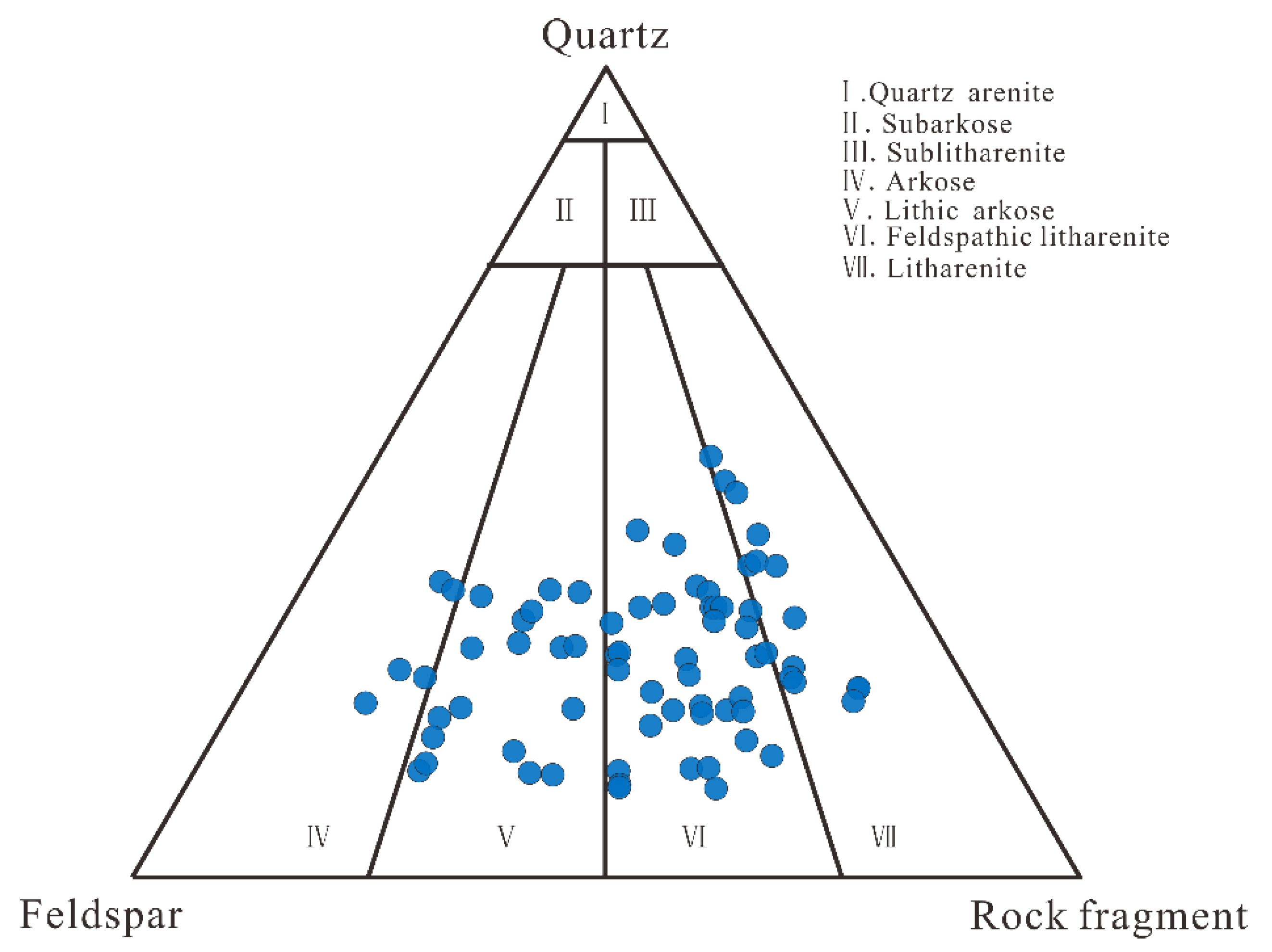
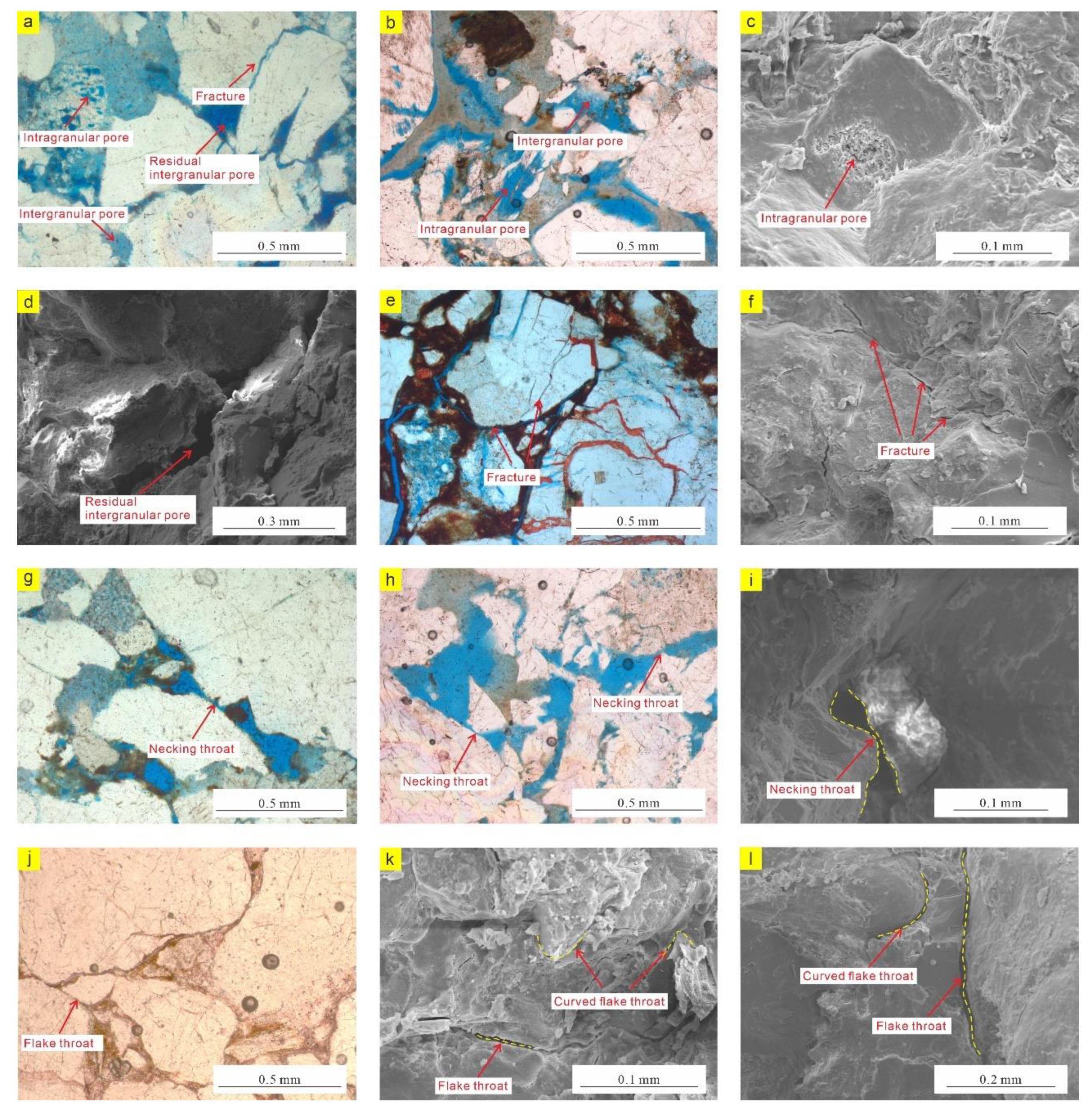

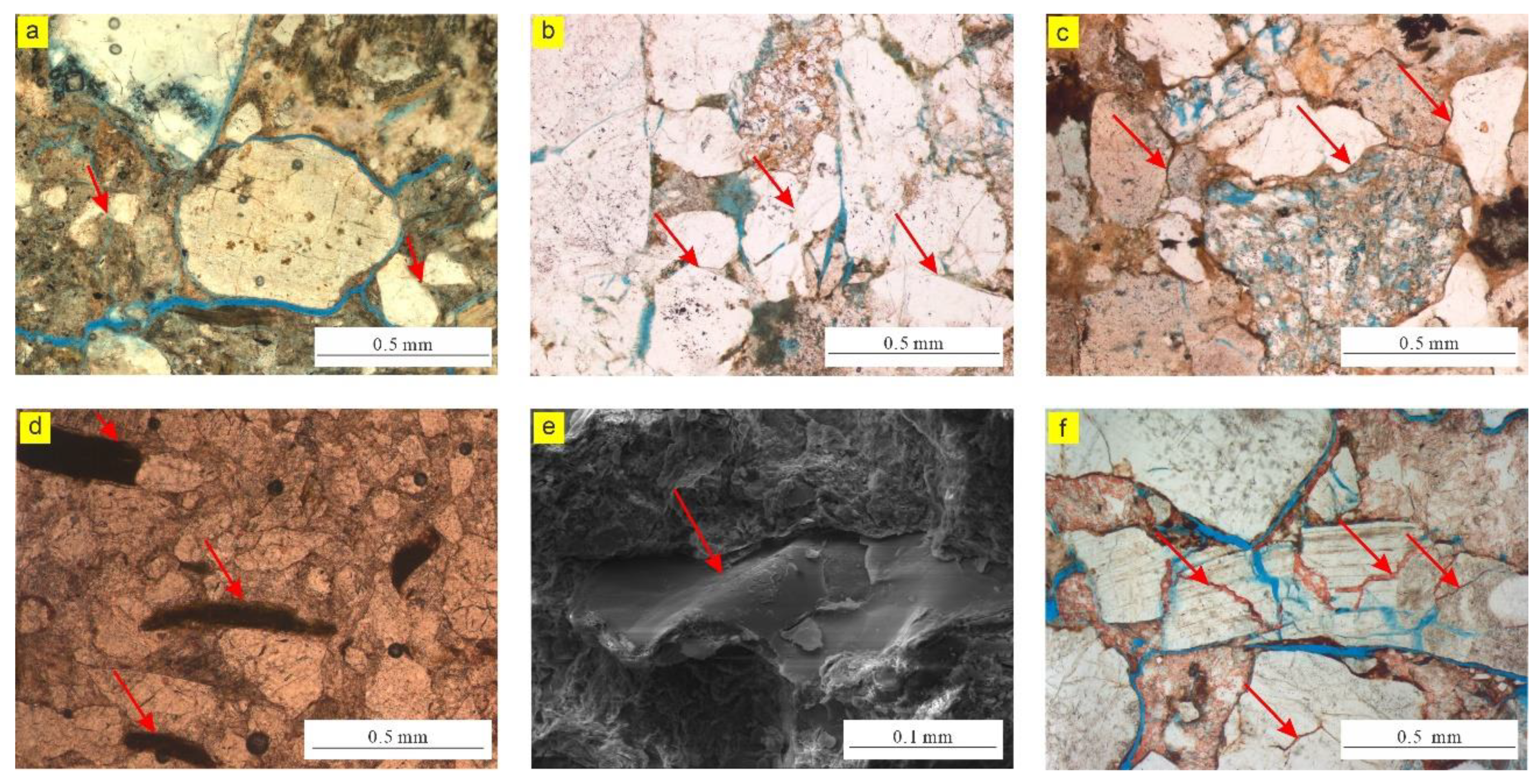

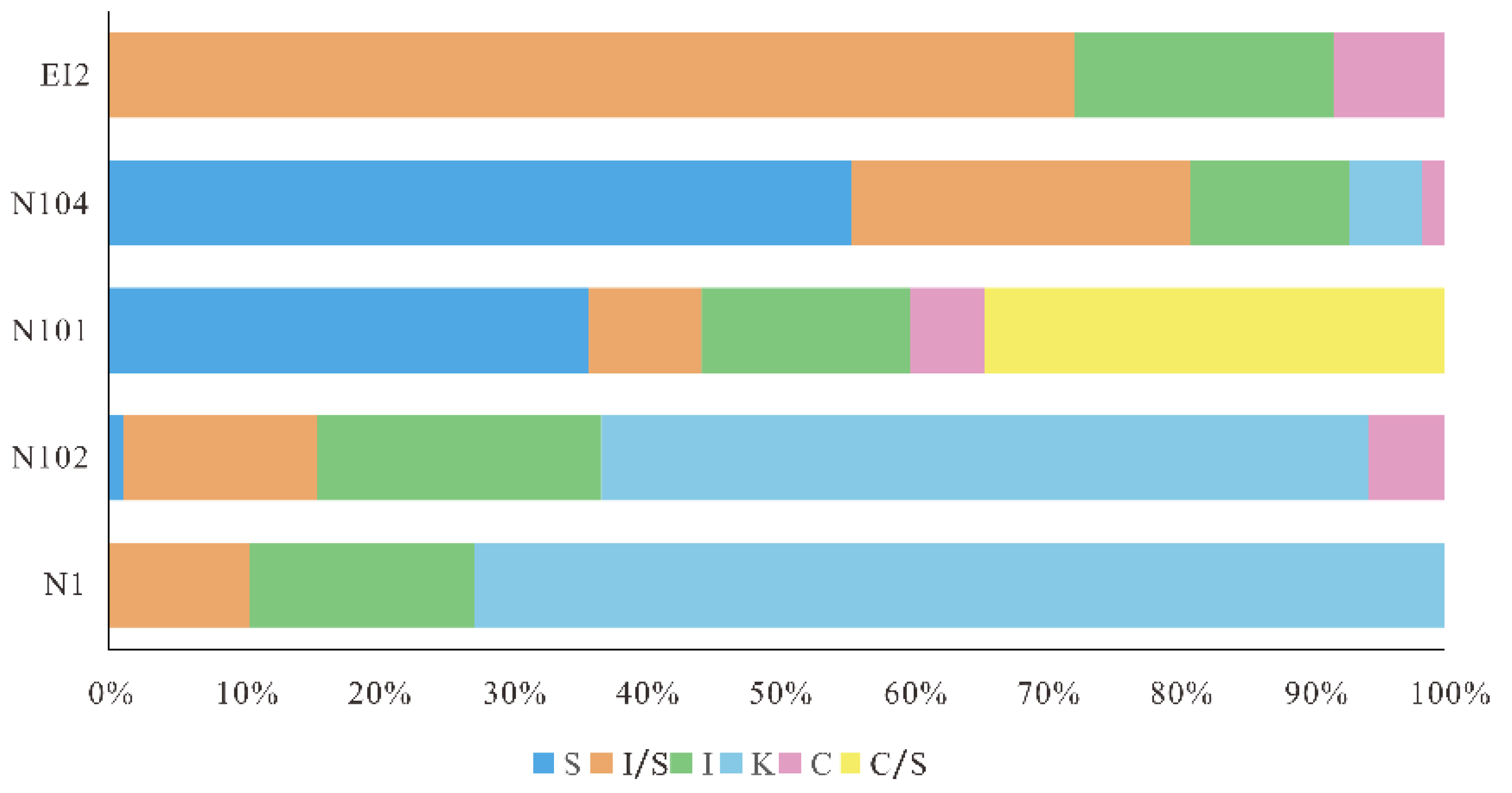
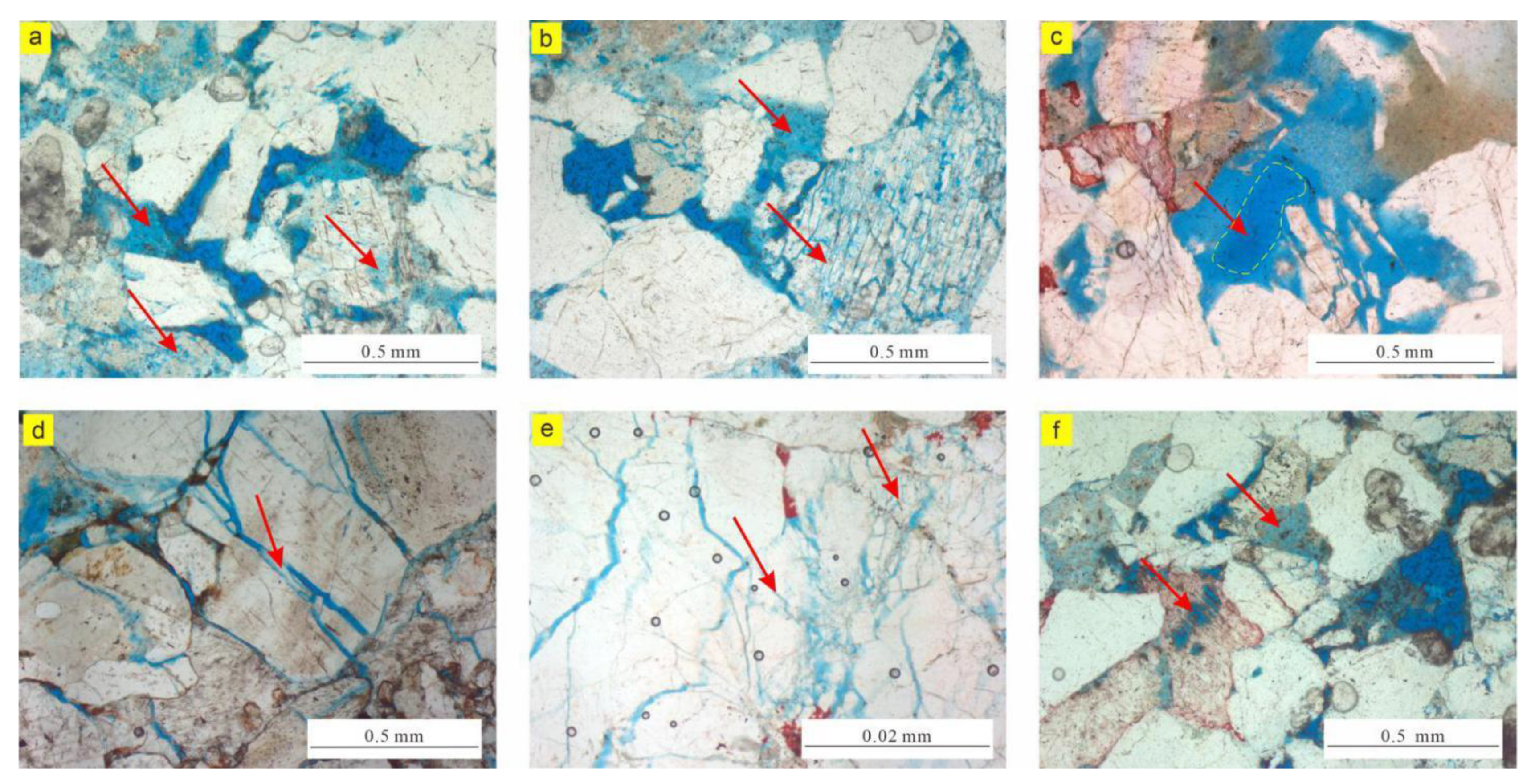

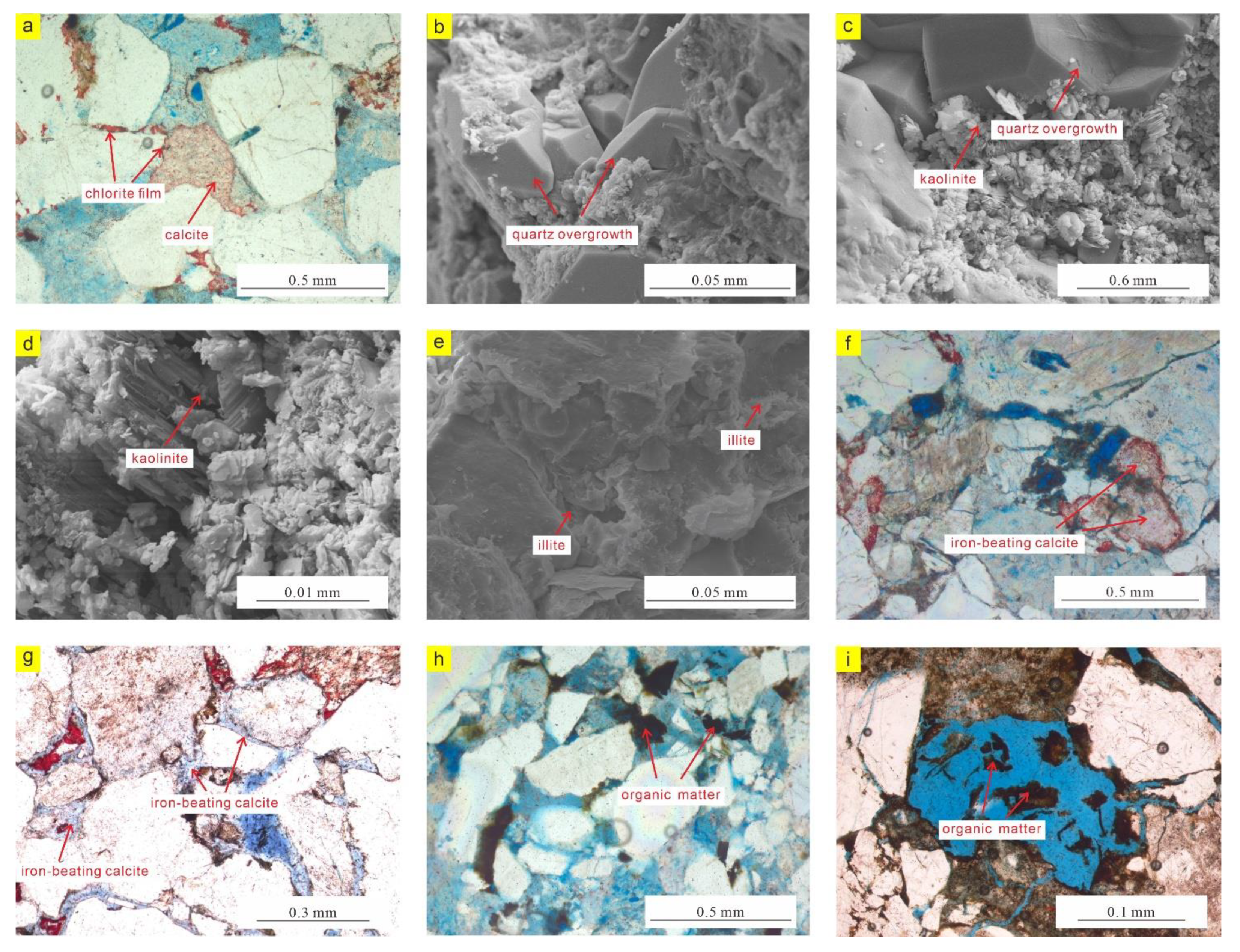
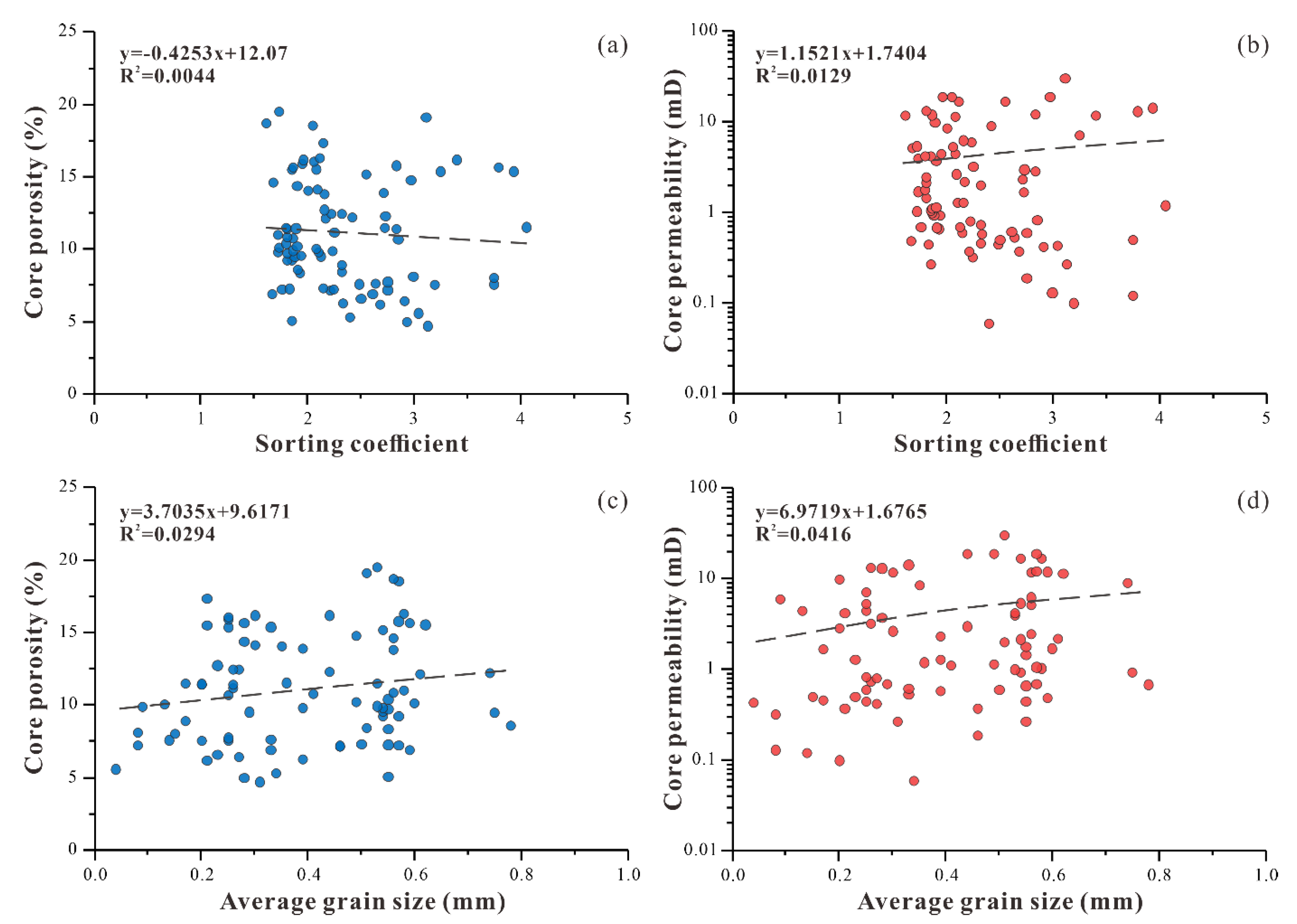
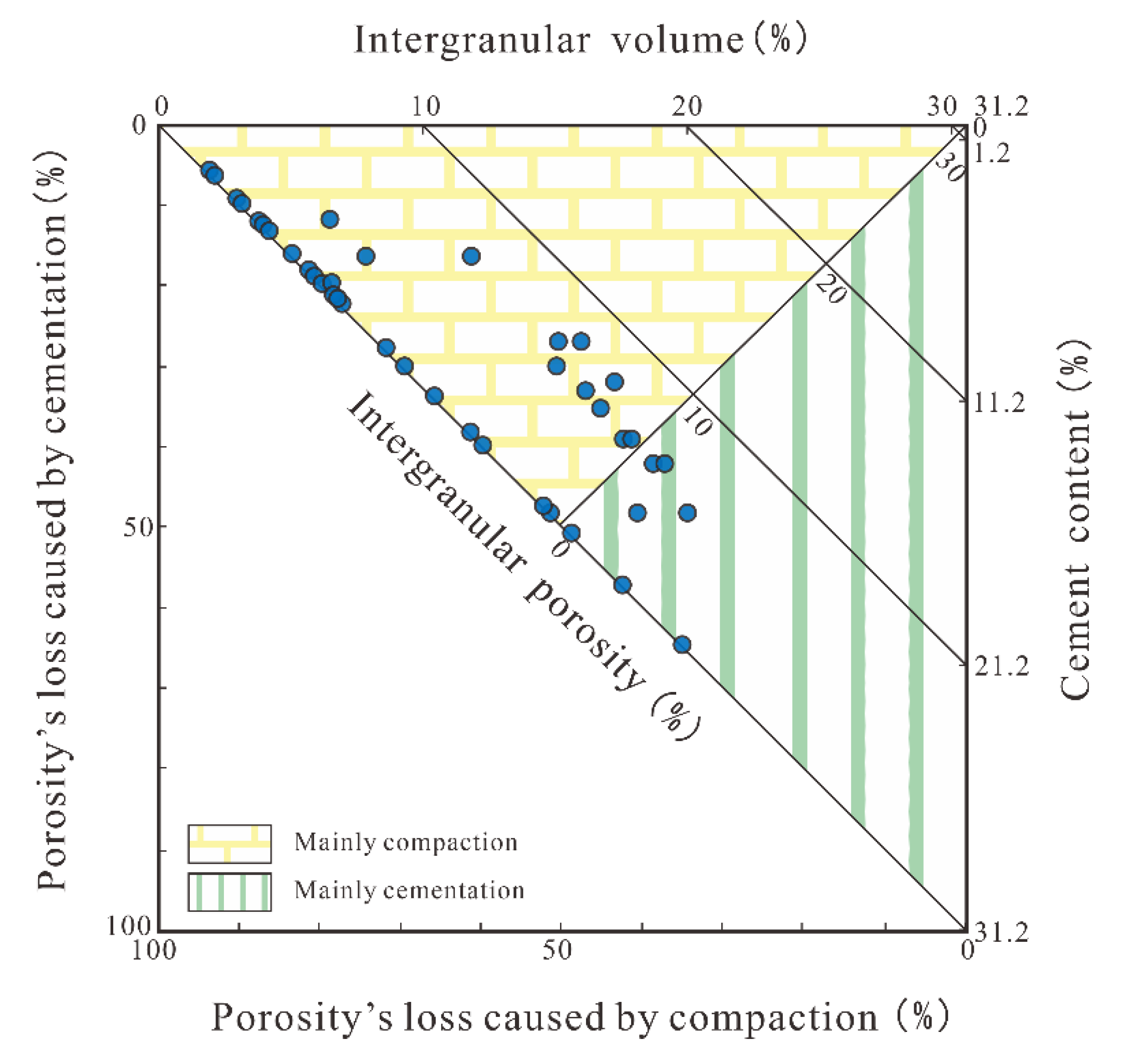
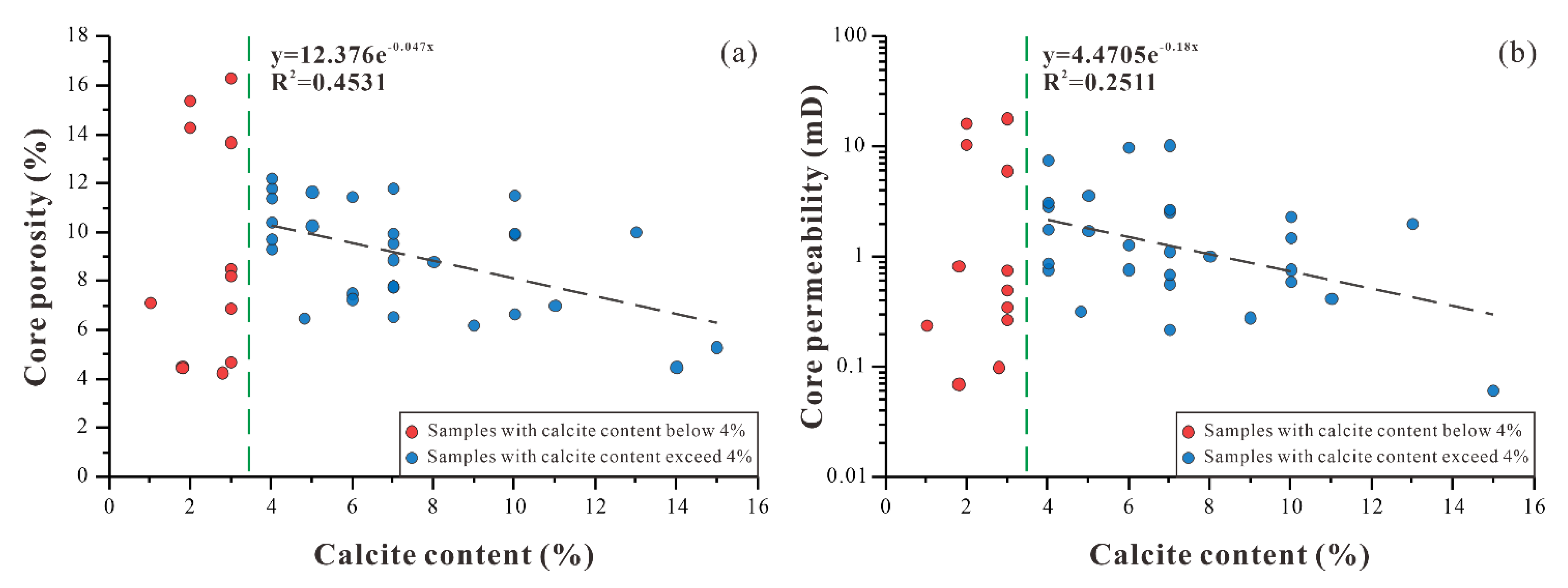
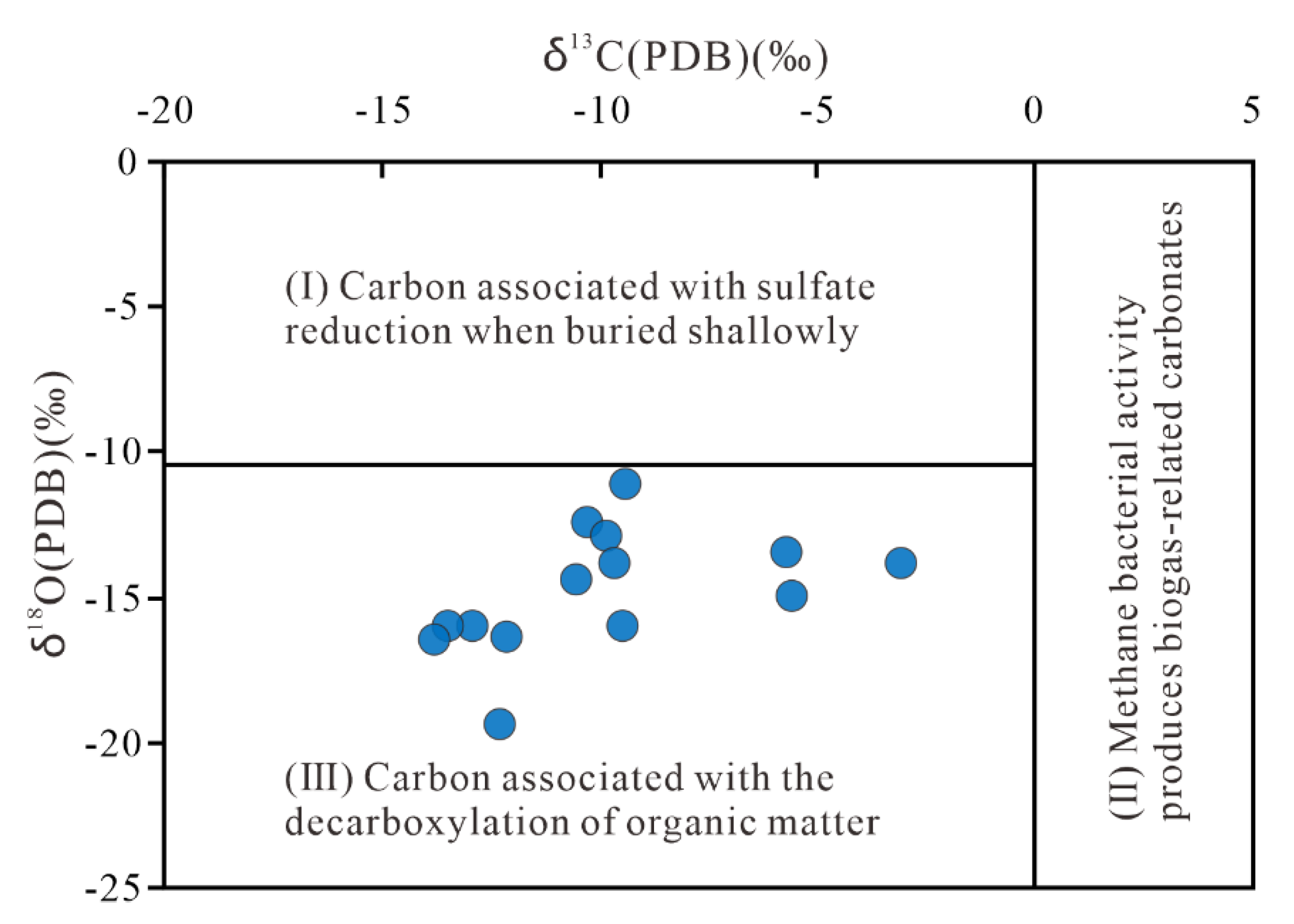
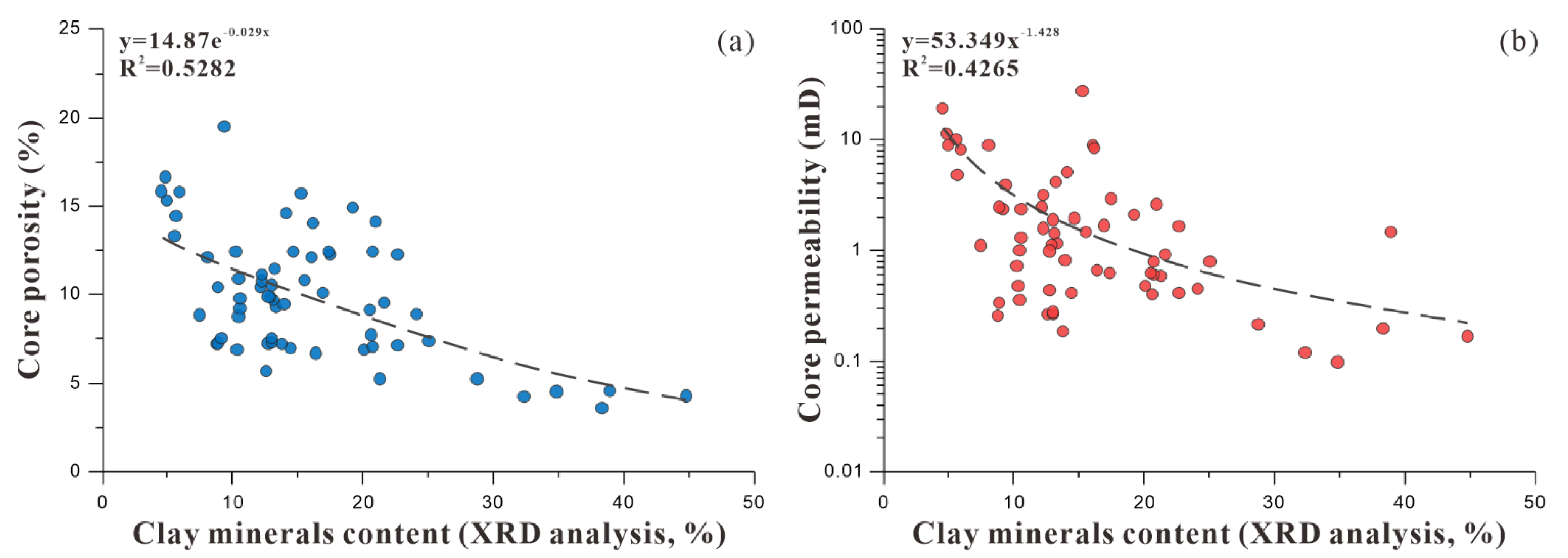
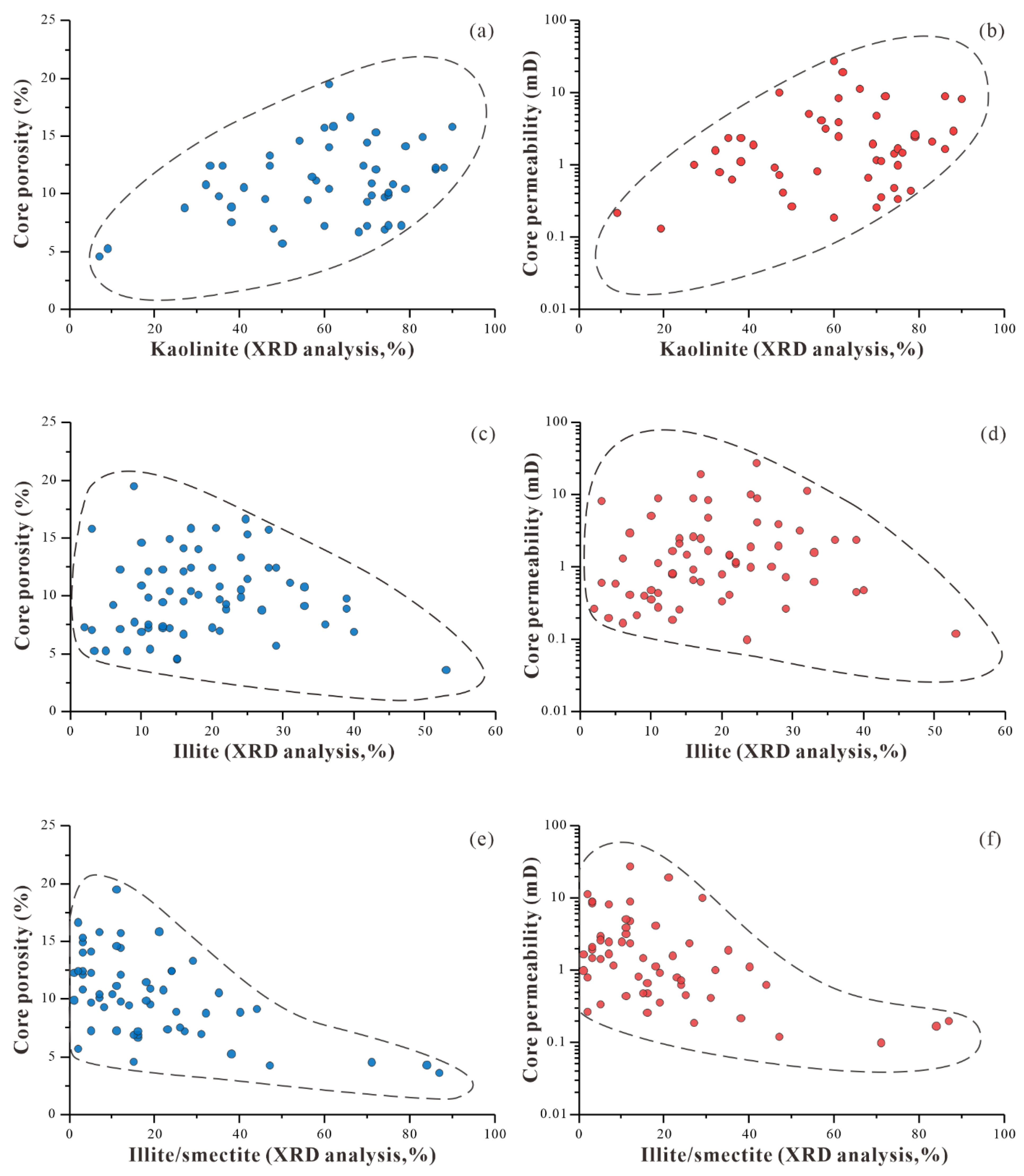

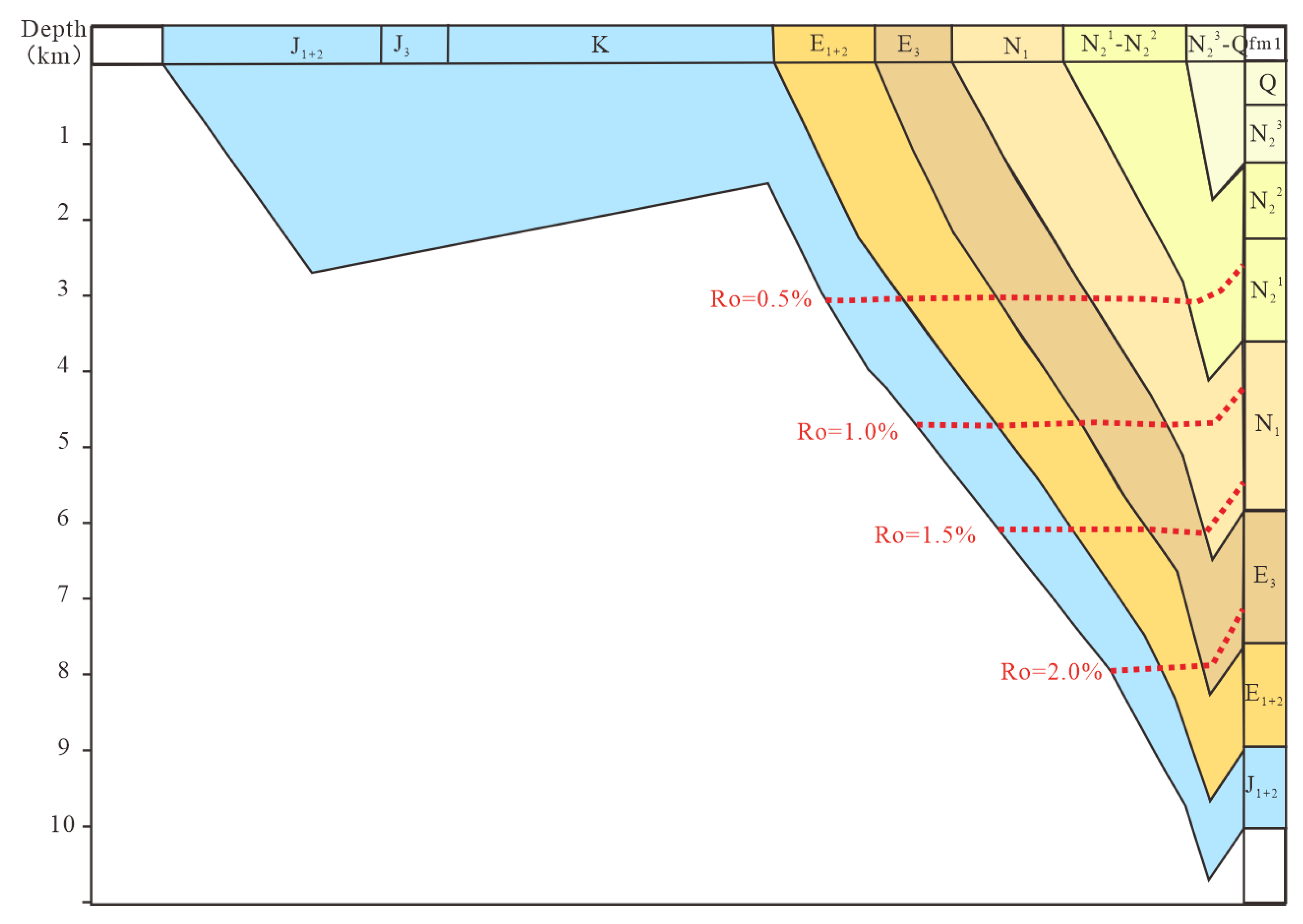

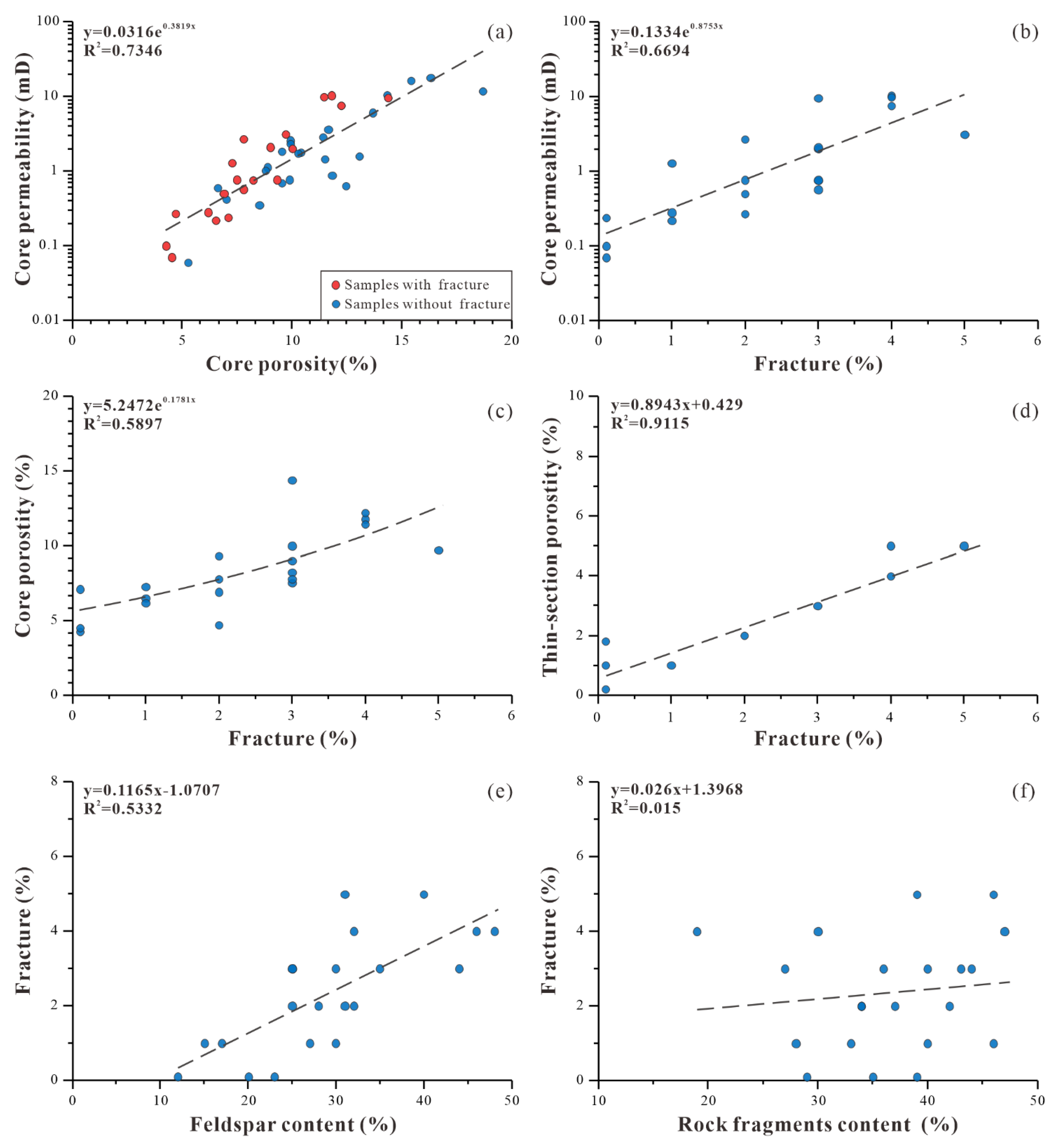
| Well | Depth(m) | Lithology | Sample | Ro, ran% |
|---|---|---|---|---|
| N2 | 2038 | Grey black mudstone | kerogen | 1.379 |
| N2 | 2210 | Black carbonaceous mudstone | kerogen | 0.876 |
| N2 | 2159 | Coal | kerogen | 1.175 |
| Average | 1.143 | |||
| Well | Depth (m) | δ13CPDB‰ | δ18OPDB‰ |
|---|---|---|---|
| N1 | 2227.17 | −10.31 | −12.37 |
| N1 | 2227.90 | −9.86 | −12.87 |
| N1 | 2228.72 | −10.56 | −14.39 |
| N1 | 2231.53 | −9.68 | −13.78 |
| N1 | 2232.17 | −9.51 | −15.96 |
| N104 | 2366.50 | −5.57 | −14.94 |
| N104 | 2367.30 | −5.69 | −13.43 |
| N104 | 2369.70 | −3.10 | −13.81 |
| EI2 | 4644.93 | −13.79 | −16.47 |
| EI2 | 4647.90 | −12.96 | −15.98 |
| EI2 | 4837.75 | −12.15 | −16.37 |
| EI2 | 4839.84 | −12.32 | −19.34 |
| Average | −9.63 | −14.98 | |
| Well | Core Porosity | Cementation | Primary Pore % | Secondary Pore % | Fracture % | Thin Section Porosity % | Sorting Sd | Unconsolidated Porosity Φ1 | Porosity after Compaction Φ2 | Porosity after Cementation Φ3 | Second Pore Porosity in Thin Sections Φ4 | Fracture Porosity in Thin Sections Φ5 |
|---|---|---|---|---|---|---|---|---|---|---|---|---|
| N102 | 4.6~18.7 | 4.0~15.0 | 0.0~6.0 | 1.0~6.0 | 0.0~1.0 | 2.0~10.0 | 1.9~2.6 | 29.9~33.0 | 6.0~20.6 | 0.0~8.2 | 1.~18.7 | 0.0~1.2 |
| 10.4(18) | 10.5(18) | 3.5(18) | 2.6(18) | 0.1(18) | 6.2(18) | 2.1(18) | 31.9(18) | 15.4(18) | 4.9(18) | 5.4(18) | 0.1(18) | |
| N1-2-22 | 12.2~16.6 | 2.0~17.0 | 0.0 | 2.0~5.00 | 0.0 | 2.0~5.0 | 2.0~2.6 | 29.7~32.1 | 2.0~17.0 | 0.0 | 12.2~16.6 | 0.0 |
| 14.8(3) | 7.7(3) | 0.0(3) | 4.0(3) | 0.0(3) | 4.0(3) | 2.4(3) | 30.5(3) | 7.7(3) | 0.0(3) | 14.8(3) | 0.0(3) | |
| N1 | 4.5~16.3 | 2.0~15.0 | 0.0 | 3.0~15.0 | 0.0 | 3.0~15.0 | 2.7 | 29.5 | 2.0~15.0 | 0.0 | 4.5~16.3 | 0.0 |
| 10.9(8) | 6.6(8) | 0.0(8) | 10.3(8) | 0.0(8) | 10.3(8) | 2.7(8) | 29.5(8) | 6.6(8) | 0.0(8) | 10.9(8) | 0.0(8) | |
| N104 | 7.3~12.4 | 4.0~21.0 | 0.0 | 0.0~1.0 | 1.0~5.0 | 1.0~5.0 | 2.0~3.0 | 28.6~32.5 | 4.0~21.0 | 0.0 | 0.0~2.4 | 7.3~12.4 |
| 10.2(10) | 8.5(10) | 0.0(10) | 0.1(10) | 3.4(10) | 3.5(10) | 2.2(10) | 31.6(10) | 8.5(10) | 0.0(10) | 0.2(10) | 9.9(10) | |
| N101 | 4.7~14.4 | 3.0~9.0 | 0.0 | 0.0 | 1.0~3.0 | 1.0~3.0 | 2.0~2.2 | 31.2~32.1 | 3.0~9.0 | 0.0 | 0.0 | 4.7~14.4 |
| 8.0(9) | 5.7(9) | 0.0(9) | 0.0(9) | 2.2(9) | 2.2(9) | 2.2(9) | 31.5(9) | 5.7(9) | 0.0(9) | 0.0(9) | 8.0(9) | |
| EI2 | 4.3~7.1 | 1.8~7.0 | 0.0~0.1 | 0.1~1.6 | 0.0~0.1 | 0.2~1.8 | 2.3~2.7 | 29.3~3.1 | 1.8~7.0 | 0.0~0.4 | 2.1~6.5 | 0.0~2.1 |
| 5.4(5) | 4.5(5) | 0.0(5) | 0.6(5) | 0.1(5) | 0.7(5) | 2.6(5) | 30.0(5) | 4.6(5) | 0.1(5) | 4.7(5) | 0.6(5) | |
| Total | 4.3~18.7 | 2.0~21.0 | 0.0~6.0 | 0.0~15.0 | 0.0~5.0 | 0.2~15.0 | 1.9~3.0 | 28.6~33.0 | 1.8~21.0 | 0.0~8.2 | 0.0~18.7 | 0.0~14.4 |
| 9.8 | 8.0 | 1.3 | 2.7 | 1.1 | 5.0 | 2.3 | 31.2 | 9.7 | 1.7 | 4.8 | 3.3 |
Publisher’s Note: MDPI stays neutral with regard to jurisdictional claims in published maps and institutional affiliations. |
© 2021 by the authors. Licensee MDPI, Basel, Switzerland. This article is an open access article distributed under the terms and conditions of the Creative Commons Attribution (CC BY) license (https://creativecommons.org/licenses/by/4.0/).
Share and Cite
Li, W.; Fan, T.; Gao, Z.; Wu, Z.; Li, Y.; Zhang, X.; Zhang, H.; Cao, F. Impact of Diagenesis on the Low Permeability Sandstone Reservoir: Case Study of the Lower Jurassic Reservoir in the Niudong Area, Northern Margin of Qaidam Basin. Minerals 2021, 11, 453. https://doi.org/10.3390/min11050453
Li W, Fan T, Gao Z, Wu Z, Li Y, Zhang X, Zhang H, Cao F. Impact of Diagenesis on the Low Permeability Sandstone Reservoir: Case Study of the Lower Jurassic Reservoir in the Niudong Area, Northern Margin of Qaidam Basin. Minerals. 2021; 11(5):453. https://doi.org/10.3390/min11050453
Chicago/Turabian StyleLi, Wenhuan, Tailiang Fan, Zhiqian Gao, Zhixiong Wu, Ya’nan Li, Xinlei Zhang, Heng Zhang, and Fangda Cao. 2021. "Impact of Diagenesis on the Low Permeability Sandstone Reservoir: Case Study of the Lower Jurassic Reservoir in the Niudong Area, Northern Margin of Qaidam Basin" Minerals 11, no. 5: 453. https://doi.org/10.3390/min11050453





